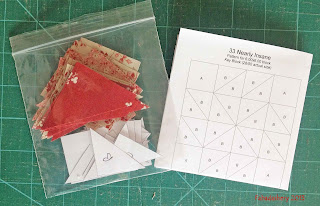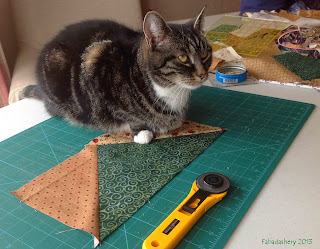 |
| Butterfly Quilt by Frances Meredith |
Inspiration
The inspiration for this scrap quilt came from a picture in a quilting
book I took out of our local library, early in my quilting journey, about 2003. The original picture in the book was no more than a couple of inches big, but it was enough for me to work out a
pattern for a block. I like a scrappy
quilt, and this quilt used all sorts of fabrics. At the time, the only patchworking I knew was
English piecing, so I made my own paper pattern, cut out all the pieces, and off
I went.
History of the
Butterflies Quilt
During the period when I was making the quilt, I went to a JOAnn’s store,
during a trip to America, where I saw a pattern of the same quilt being sold on
the shelves. I guess it was only then that I realised that the quilt I was
making already had a history. Further
research when I returned home to the UK revealed that a pattern, and the history
of the quilt was published in a book “The New England Quilt Museum Quilts: Featuring the Story of the Mill Girls -Instructions for 5 Heirloom Quilts” by Jennifer Gilbert (Paperback,1999)
[NB: Which I notice you can currently access via Google Books]. I discovered that it was originally made in about
1935, by a lady called Nina Shrock, Harvard County, Indiana, USA, using a
design by Laura Wheeler. When we were back in America in the Autumn of 2007, we
made a pilgrimage to the New England Quilt Museum, in Lowell, where we able to
see the quilt on display, the one I had seen originally in my library book,
back in the UK. It was a nice feeling. I
now have a pencil with the same butterflies on it, as a memento!
What fabrics did I
use?
My creative journey has included dressmaking and embroidery, and it was only in
about 2002 that I inherited a collection of beautiful quilting fabric and I
considered doing some quilting. Amongst the collection were packets of fabrics,
which I later learnt were called Charm Packs.
There were 5” squares, 4“ squares, and tiny 1.5” squares, mainly from a
mail order company, Strawberry Fayre based in Chagford in Devon, UK. I wanted a project that was going to use
these up, and the scrappy nature of the quilt, seemed like the ideal
choice.
However, I did notice in the small picture that there were ‘constants’. For instance, the body of the butterfly was
the same for each. I did not have
anything suitable, so I went to my local quilting and patchwork shop, BusyBees, based in the Craft Units at Tredegar House in Newport, Wales. There I found a brown batik fabric. I was recommended to give it a wash before I
used it. I think that was a good idea.
Otherwise, I didn’t wash any of the fabric – the bits were too small.
There is a whole mix in there. Ironically, it was only after I had completed
the quilt that it was brought to my attention that there were a lot of 30’s
reproduction fabrics in it. This was not
intentional, it was serendipity at work.
At the time I didn’t realise what 30’s reproduction fabrics were. I also have one or two bits of special fabric
in there, including the first piece of fabric I ever bought, at the Marldon
Apple Pie Fair in Devon, back in the early 1980’s. You can see details of Techniques and Construction in this post.

























